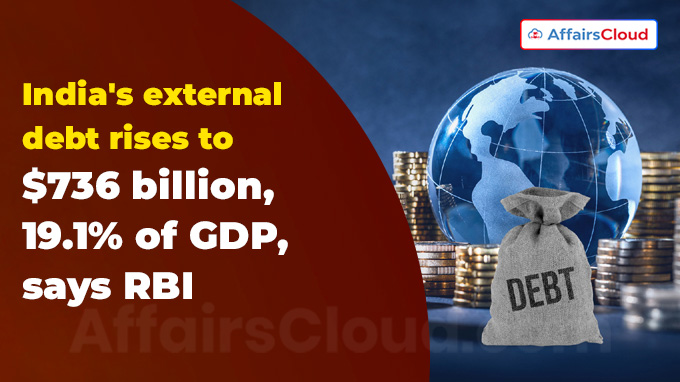 On June 27th 2025, the Reserve Bank of India (RBI) reported that India’s external debt rose by 10% to USD 736.3 billion (bn) at the end of March 2025, compared to USD 668.8 bn at the end of March 2024.
On June 27th 2025, the Reserve Bank of India (RBI) reported that India’s external debt rose by 10% to USD 736.3 billion (bn) at the end of March 2025, compared to USD 668.8 bn at the end of March 2024.
- The external debt to GDP (Gross Domestic Product) ratio increased to 19.1% at end-March 2025 from 18.5% at end-March 2024.
Valuation Effect:
The valuation effect reduced the increase in external debt from USD 72.9 bn to USD 67.5 bn at end-March 2025 over end-March 2024.
- Valuation effect due to the appreciation of the US dollar vis-à-vis the Indian rupee and other currencies amounted to USD 5.3 bn
Long-Term and Short-term Debt:
i.The long-term debts with original maturity of above one year was recorded at USD 601.9 bn,
- While the short-term debt (maturity less than one year) stood at USD 134.5 bn, declining to 18.3% of total external debt at the end-March 2025 from 19.1% at end-March 2024.
- However, the ratio of short-term debt to foreign exchange reserves rose slightly to 20.1%, up from 19.7% at end of March 2024.
ii.Short-term debt on a residual maturity basis, which includes both long-term debt maturing within the next 12 months and short-term debt by original maturity accounted for 41.2% of total external debt at end-March 2025, down from 43.4% (March 2024).
- It also stood at 45.4% of foreign exchange reserves, compared to 44.9% at end-March 2024.
Other Key Highlights:
i.The composition of India’s external debt was led by US dollar-denominated debt at 54.2%, followed by:
- Indian rupee (31.1%)
- Yen (6.2%)
- Special Drawing Right (SDR) (4.6%)
- Euro (3.2%)
ii.The share of outstanding debt of non-financial corporations in total external debt was the highest at 35.5%, followed by:
- deposit-taking corporations (except the central bank) at 27.5%
- General government at 22.9%
- Other Financial Corporation at 9.4%
iii.Loans formed the largest share of India’s external debt, making up 34.0% of the total, followed by:
- Currency and deposits at 22.8%
- Trade credit and advances at 17.8%
- Debt securities at 17.7%.
iv.Debt service (i.e., principal repayments and interest payments) marginally declined to 6.6% of current receipts at end-March 2025, from 6.7% at end-March 2024.
Note:
- Valuation effect refers to the change in the value of external debt (or assets) that happens not because of actual borrowing or repayment, but because of changes in currency exchange rates or market prices.
- Current receipts refer to the country’s earnings from exports of goods and services, primary income (such as interest and dividends), and secondary income (like remittances). These are the main sources of foreign exchange used to service external debt.
About Reserve Bank of India:
Under Section 45ZA, the Central Government, in consultation with the RBI, determines the inflation target in terms of the Consumer Price Index (CPI), once in five years and notifies it in the Official Gazette. The inflation target for April 1, 2021 to March 31, 2026 is 4% CPI with an upper tolerance limit of 6% and the lower tolerance limit of 2%
Governor – Sanjay Malhotra
Headquarters – Mumbai (Maharashtra)
Established – April 1,1935




